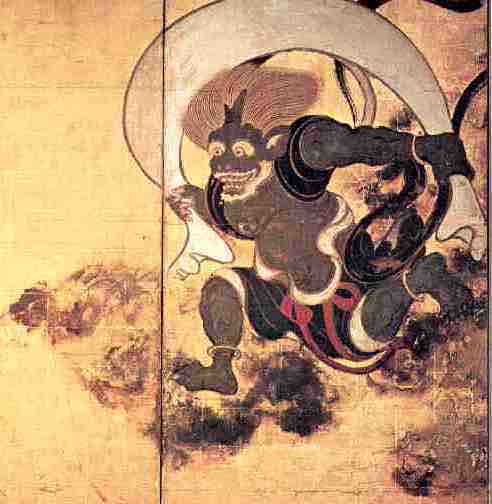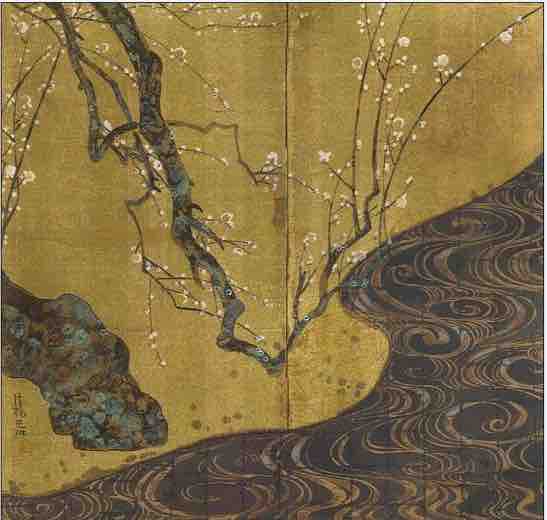Background: The Edo Period
In the Edo (江) or Tokugawa (徳) period between 1603 to 1868, Japan was under the rule of the Tokugawa shogunate, a form of military rule headed by the shogun. The period was characterized by economic growth, strict social order, isolationist foreign policies, increased environmental protection, and popular enjoyment of the arts. It was officially established in Edo on March 24, 1603 by Tokugawa Ieyasu (1543–1616). The period came to an end with the Meiji Restoration on May 3, 1868, after the fall of Edo to forces loyal to the Emperor.
One of the dominant themes in the Edo period was the repressive policies of the shogunate and the attempts of artists to escape these strictures. The foremost of these strictures was the closing of the country to foreigners and the imposition of strict codes of behavior affecting many aspects of life, including the clothes one wore, the person one married, and the activities one could or should not pursue. In the early years of the Edo period, however, the full impact of Tokugawa policies had not yet been felt, and some of Japan's finest expressions in architecture and painting were produced by the Rinpa school.
The Rinpa School
Style and Technique
Rinpa artists worked in various formats, notably screens, fans, hanging scrolls, woodblock printed books, lacquerware, ceramics, and kimono textiles. Many Rinpa paintings were used on the sliding doors and walls (fusuma) of noble homes. Subject matter and style were often borrowed from Heian period traditions of Yamato-e, with elements from Muromachi ink paintings, Chinese Ming dynasty flower-and-bird paintings, and Momoyama period Kanō school developments. The stereotypical standard painting in the Rinpa style involves simple natural subjects such as birds, plants, and flowers with the background filled in with gold leaf. Emphasis on refined design and technique became more pronounced as the Rinpa style developed.
The Development of the School
Rinpa is one of the major historical schools of Japanese painting. In 1615, Hon'ami Kōetsu founded an artistic community of craftsmen, supported by wealthy merchant patrons of the Nichiren Buddhist sect at Takagamine in northeastern Kyoto. Merchants, who were the lowest of the four social classes and often considered unproductive members of society, were increasingly relied on by the samurai for the production of consumer goods and artistic works. Both the affluent merchant town elite and the old Kyoto aristocratic families favored arts which followed classical traditions, and Kōetsu obliged by producing numerous works of ceramics, calligraphy, and lacquerware. Kōetsu's collaborator, Tawaraya Sōtatsu, maintained an atelier in Kyoto and produced commercial paintings such as decorative fans and folding screens. Sōtatsu specialized in making decorated paper with gold or silver backgrounds, which Kōetsu assisted by adding calligraphy.
The Founders: Hon'ami Kōetsu and Tawaraya Sōtatsu
Both artists came from families of cultural significance. Kōetsu came from a family of swordsmiths who had served the imperial court and great warlords and shoguns. Kōetsu's father evaluated swords for the Maeda clan, as did Kōetsu himself. However, Kōetsu was less concerned with swords and more interested in painting, calligraphy, lacquerwork, and the Japanese tea ceremony (he later created several Raku ware tea bowls). His own painting style was flamboyant, recalling the aristocratic style of the Heian period.
Sōtatsu also pursued the same classical Yamato-e genre as Kōetsu, but he pioneered a new technique with bold outlines and striking color schemes. Two of his most famous works include the folding screens "Wind and Thunder Gods" (風 Fūjin Raijin-zu), located in Kennin-ji temple in Kyoto, and "Matsushima" (松) at the Freer Gallery in Washington, DC.

Early Rinpa school work
Portion of Sōtatsu's Fūjin Raijin-zu, "Wind and Thunder Gods". 17th century.
Ogata Kōrin and Ogata Kenzan
The Rinpa school was revived in the Genroku era (元 1688–1704) by Ogata Kōrin and his younger brother Ogata Kenzan, sons of a prosperous Kyoto textile merchant. Kōrin's innovation was to depict nature as an abstract, using numerous color and hue gradations, mixing colors on the surface to achieve eccentric effects, and liberally using precious substances like gold and pearl.
Kōrin's masterpiece "Red and White Plum Trees" (紅 Kōhakubai-zu, c. 1714–15) is now at the MOA Museum of Art in Atami, Shizuoka. As a dramatic composition, it established the direction of Rinpa for the remainder of its history. Kōrin collaborated with Kenzan in painting designs and calligraphy on his brother's pottery. Kenzan remained a potter in Kyoto until after Kōrin's death in 1716, when he began to paint professionally. Other Rinpa artists active in this period were Tatebayashi Kagei, Tawaraya Sōri, Watanabe Shikō, Fukae Roshū, and Nakamura Hōchū.

Portion of Ogata Kōrin's Kōhakubai-zu
Kōrin's "Red and White Plum Trees" (1714/15) established the direction of Ripa for the remainder of its history.
Sakai Hōitsu
Rinpa was revived again in 19th century Edo by Sakai Hōitsu (1761–1828), a Kanō school artist whose family had been one of Ogata Kōrin's sponsors. Sakai published a series of 100 woodcut prints based on paintings by Kōrin, and his painting "Summer and Autumn Grasses" (夏 Natsu akikusa-zu) is painted on the back of Kōrin's "Wind and Thunder Gods screen" is now at the Tokyo National Museum.